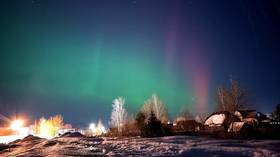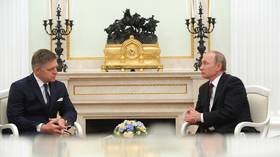Northern lights deliver spectacular show over Russia (PHOTOS)

Stunning images of the aurora borealis, also known as the northern lights, were captured in the skies above multiple Russian cities on Sunday.
People from the northern regions of Leningrad, Tver, Pskov, and Novgorod, as well as the cities of Volokolamsk and Murmansk, shared breathtaking photographs of the natural phenomenon. The impressive light show, which is caused by solar storms, began at around 8pm and lasted until midnight.
“Right now, you can see the northern lights above the zenith,” a person from Pskov said in a local astronomy group on social media network VK at 8.45pm on Sunday.
“The green liquid has spilled over,” another person said, sharing stunning photos of the lights above his town.
The skies in Karelia also looked epic, lit up by a range of colors.
An amazing image came in from Zvenigorod in Moscow Region.
And a fantastic shot from Veliky Novgorod.
The aurora borealis phenomenon generally occurs in the Earth’s polar regions and is best seen during the late evening and night time between September and April, when the sky becomes dark.
It is caused by geomagnetic storms when charged particles from the Sun, mainly electrons and protons, interact with Earth’s magnetic field and atmosphere, creating an aurora.
The color of the light depends on which gas is being excited by the electrons and how much energy is being exchanged. Oxygen emits greenish-yellow or red light, while nitrogen produces blue light. The shape of the light depends on where in the magnetosphere the particles came from.
The current light show is caused by the colossal Sunspot AR3590, which recently unleashed the most potent solar flare in over half a decade towards Earth.













